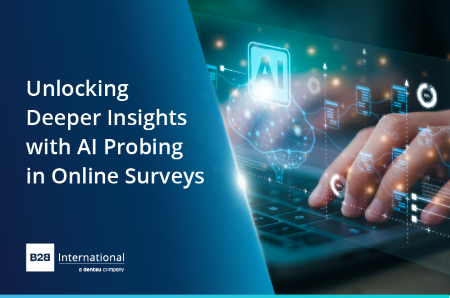
The foundation of B2B market research is to uncover the opinions of business decision-makers, whether through quantitative measures of their views or qualitative explorations to dig deeper into trends. However, some critics, such as David Ogilvy, suggest that direct questioning cannot lead to accurate answers: “The problem with market research is that people do not think how they feel, they do not say what they think, and they do not do what they say.”
While there is much debate around Ogilvy’s view on market research, it is true that some respondents find it difficult to articulate their thoughts, especially when discussing brands they use for B2B purchases. One effective method to break down these barriers is through projective techniques.
Projective techniques are loosely based on approaches used in psychotherapeutic sessions, allowing participants to project their feelings or emotions onto inanimate objects and experiences. The Oxford University Press Dictionary of Psychology defines projective techniques as “any series of personality tests in which the respondent gives free responses to a series of stimuli such as inkblots, pictures, or incomplete sentences… the assumption being that respondents project unconscious aspects of their personalities onto the test items and reveal them in their responses.” This allows respondents to bypass any reasons to conceal their thoughts and draw conclusions from the subconscious.
Although the most famous example of this technique is the Rorschach test, we are not interested in finding out whether B2B decision-makers can see their parents arguing in an inkblot. Instead, there are a variety of methods that can be used both in-person and remotely to extract insights from this audience.

Examples of Projective Techniques in B2B Market Research
Personification
This method asks respondents to imagine something inanimate (often a brand) as something else. Good topics for personification include people and animals but can also be specific to a certain sector. By asking why the response was given, researchers can dig into why this association was made and prompt on other factors that are not initially mentioned.
B2B International not only advocates for this method but also uses it in our own customer experience (CX) research to explore how our brand is perceived, including identifying strengths and areas for improvement.
Word Association
This is the most common form of projective technique used in B2B market research today. Participants suggest words that they associate with the research topic. It is useful to ask them to do this quickly so that they cannot overthink their response and instead give top-of-mind associations.
Researchers can follow up by asking why these words were selected and coding responses to provide quantitative figures and trend perceptions over time. This method can be used in various surveys, including customer experience, branding, thought leadership, and more.
Bubble Drawing
Respondents are shown stimuli relevant to the research (e.g., an image of an individual or an experience) and asked to fill in a speech or thought bubble. This technique, based on the Thematic Apperception Test (TAT), helps uncover hidden feelings or emotions by projecting them onto a neutral object or scene.
Sentence Completion
Similar to bubble drawing, sentence completion is particularly useful in online surveys where participants can enter text to complete a given sentence. This method helps reveal underlying thoughts and feelings that might not be expressed through direct questioning.

Collage Technique
By providing participants with magazines or other visual materials, they can cut and arrange aspects to create a collage. This technique is useful for exploring experiences with brands or activities, as well as the “feel” of any stimuli they have been shown. A mood board is a good example of this, where individuals place stimuli on the board to represent a mood, atmosphere, or feeling.
Mapping is an alternative method where, instead of magazines and other such stimuli, participants are given objects. Respondents sort or map these objects according to how they are perceived. This can be done either with physical objects or visual representations. For example, a focus group run by B2B International in China asked respondents to make a collage with their views on who eats sausages. Following this rather unusual task, respondents created unique collages with materials that allowed us to capture these visual insights, as well as their explanations to accompany the collages.
Psycho-Drawing
In this technique, individuals are asked to draw something relevant to the research, such as a brand or experience, often in an abstract manner. Following this exercise, having the respondent describe their drawing and what it represents can help mitigate the issue of interviewer interpretation. This method can reveal deep-seated perceptions and emotions that might not surface through direct questioning.
Role Play
Role play is usually conducted within a group setting but can also be done one-on-one. Respondents are asked to act out a role and perform, opening up with their interpretation of brands, experiences, activities, etc. This task requires careful introduction and sensitivity, as many may be reluctant to participate. By introducing this later in the discussion, respondents are more likely to be receptive and less likely to close off.
Brand / Blob Tree
This activity provides a visual stimulus of a tree, shown to respondents with various characters (blobs) engaging in activities and presenting different, easy-to-read emotions. Respondents can circle one or more characters that represent their thoughts on a brand or experience. This method helps in visualizing and articulating complex feelings and perceptions.
Brand Contract
In this technique, respondents are given a series of prompts and asked to fill in the rest of the contract. This method is effective in uncovering initial expectations of the brand or experience and then measuring these against actual performance. It provides a structured way to capture detailed insights into customer expectations and satisfaction.
The Six Hats
This method is used in a group setting, where respondents mentally wear and switch ‘hats’ to change the way they think about experiences, brands, activities, etc. Each hat represents a different perspective or mode of thinking (e.g., logical, emotional, creative), encouraging participants to explore various angles and insights. This technique fosters a comprehensive understanding of the research topic by considering multiple viewpoints.

Key Limitations of Projective Techniques to be Aware Of
Before including projective techniques in your future programs, it is important to note some key limitations of using this method:
Interviewer Interpretation
The interpretation of projective results can often be as subjective as the techniques themselves. Interviewers and data analysts may place their own interpretation or spin on the data, which can go beyond the respondent’s intentions. Asking respondents to explain their reasoning can help mitigate this issue, though it may still leave some opinions uncovered. Ensuring that multiple analysts review the data can also help provide a more balanced interpretation.
Unconscious Bias
External factors, as well as the placement of the question in the survey, may impact respondents’ answers. For example, if respondents are having a bad day, they may be more likely to project negative feelings unrelated to the research topic. Additionally, if they are probed throughout a questionnaire on aspects of a brand, they may carry these themes over when asked to use a projective method. To minimize this, it is crucial to carefully design the survey flow and consider the timing and context of projective questions.
Interviewer Personality
The personal characteristics of the interviewer can significantly impact the respondent’s level of participation and the depth of the answers provided. A “warm, friendly, interested, and relaxed” approach is recommended (Will, et al., 1996). Skilled depth interviewers are trained to provide this environment, but it does not guarantee success for these methods. Consistency in interviewer training and approach can help mitigate this limitation.
Conclusion
Projective techniques are a valuable method for uncovering the subconscious views of research participants and providing a creative line of questioning that can reveal new insights not easily uncovered through direct questioning. While there are limitations such as interviewer interpretation, unconscious bias, and interviewer personality, there are solutions to mitigate these issues. The variety of techniques available provides flexibility to use the method best suited to the research objectives.
In conclusion, projective methods should not be used exclusively to gather feedback. However, including at least one projective technique in your research project can add substantial value and provide new insights for your business. By combining these techniques with traditional methods, researchers can gain a more comprehensive understanding of their audience’s true thoughts and feelings.
Readers of this article also viewed:
The Why Behind the What: The Ultimate Guide to Qualitative Research in B2B How to Reach Senior Professionals in B2B Market Research Unlocking Deeper Insights with AI Probing in Online Surveys A Guide to Digital Ethnography in B2B Market Research 3 Top Tips for Running Effective Online Focus Groups The Benefits of Conducting In-Person Focus Groups When to Use Qualitative Research to Better Understand Your Customers and Their Needs 3 Key Factors Impacting Cost and Project Success in Market Research A Mixed Methods Approach to Market Research: Benefits and Considerations
To discuss how our tailored insights programs can help solve your specific business challenges, get in touch and one of the team will be happy to help.

